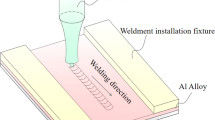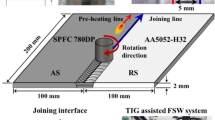Abstract
The application of lightweight materials in automotive industry creates the demand to develop reliable and cost-effective solutions for joining hybrid material parts and assemblies. In this work, the microstructure and mechanical properties of the dissimilar joint between aluminum alloy 6061 (AA6061) and carbon fiber-reinforced polyphenylene sulfide (CF-PPS) processed by refill friction stir spot welding (RFSSW) were investigated. The results show that the joining between AA6061 and CF-PPS is attributed to the combined effect of mechanical interlocking and adhesive bonding. The rotation speed affects the porosity at the AA6061/CF-PPS interface which is the governing factor of the joints’ peak load during the lap-shear test. Varying rotation speed from 1000 to 1400 rpm, it illustrated that the lap-shear joints produced under 1200 rpm possess the highest peak load of 1460 N. Besides, it is observed that the joints produced with 1200 rpm have a thicker adhesive layer, which possess a strong mechanical interlocking effect. The failure mechanism for the joints includes cohesive and adhesive fracturing. Under the optimized rotation speed, the fracturing surface of the sample possess dimples with fiber pull-outed fibers, which infers a ductile failure.













Similar content being viewed by others
References
Li HY, Dai Y, Lyu XF (2018) Application of carbon fiber reinforced composites on lightweight design of articulated platform[J]. Mater Sci Forum 921:85–90
Billur E, Teague R, Çetin B et al (2018) Economics of hot stamping[J]. Hot Stamping of Ultra High-Strength Steels 10:225–245
Zhang K, Yang Z, Li Y (2013) A method for predicting the curing residual stress for CFRP/Al adhesive single-lap joints[J]. Int J Adhes Adhes 46(5):7–13
Lambiase F, Ko DC et al (2016) Feasibility of mechanical clinching for joining aluminum AA6082-T6 and carbon fiber reinforced polymer sheets[J]. Mater Des 107(10):341–352
Palardy G, Villegas I (2015) Ultrasonic welding of thermoplastic composites with flat energy directors: influence of the thickness of the energy director on the welding process. Conference: International Conference on Composite Materials, Copenhagen, Denmark, 19-24th, July, 2015
Lionetto F, Morillas MN, Pappadà S (2018) Hybrid welding of carbon-fiber reinforced epoxy based composites. Compos A Appl Sci Manuf 104:32–40
Esteves JV, Goushegir SM, Santos JFD et al (2015) Friction spot joining of aluminum AA6181-T4 and carbon fiber-reinforced poly(phenylene sulfide): effects of process parameters on the microstructure and mechanical strength[J]. Mater Des 66(2):437–445
Goushegir SM, Dos Santos JF, Amancio-Filho ST (2015) Influence of process parameters on mechanical performance and bonding area of AA2024/carbon-fiber-reinforced poly(phenylene sulfide) friction spot single lap joints[J]. Mater Des 83:431–442
André NM, Goushegir SM, Dos Santos JF et al (2017) Influence of the interlayer film thickness on the mechanical performance of AA2024-T3/CF-PPS hybrid joints produced by friction spot joining[J]. Weld Int 32:1–10
Andre NM, Goushegir SM, Dos Santos JF et al (2016) Friction spot joining of aluminum alloy 2024–T3 and carbon-fiber-reinforced poly(phenylene sulfide) laminate with additional PPS film interlayer: microstructure, mechanical strength and failure mechanisms[J]. Composites 94:197–208
André NM, Goushegir SM, Scharnagl N et al (2017) Composite surface pre-treatments: improvement on adhesion mechanisms and mechanical performance of metal-composite friction spot joints with additional film interlayer[J]. J Adhes 94:723–742
Goushegir SM, Dos Santos JF, Amancio-Filho ST et al (2017) Influence of aluminum surface pre-treatments on the bonding mechanisms and mechanical performance of metal-composite single-lap joints[J]. Weld World 61:1099–1115
Goushegir SM, Scharnagl N, Santos JFD et al (2015) XPS analysis of the interface between AA2024-T3/CF-PPS friction spot joints[J]. Surf Interface Anal 48(8):706–711
Ogawa Y, Xiong Y, Akebono H et al (2018) Fatigue properties of friction stir welds of treated Al to carbon fibre-reinforced plastic[J]. Sci Technol Weld Joining 23:79–86
Tanaka K, Teramura T, Katayama T, Nishiguchi K (2016) Friction stir spot welding of CFRP and aluminum alloy with themoplastic adhesive. Proceedings of the 2nd International Conference on High Performance and Optimum Design of Structures and Material, Siena, Italy
Xu J, He X, Zeng K, et al. (2014) Effect of the technology characteristics of self-piercing riveting[J]. Trans China Weld Inst 35(7):91–95
Yang Y (2016) Simulation and experimental investigation on adhesive bonding process and mechanical behavior of steel/CFRP joint [D]. JiangSu University, ZhengJiang, pp 84
Schuberth A, Lindner T, Scharf I et al (2016) Effect of new adhesion promoter and mechanical interlocking on bonding strength in metal-polymer composites[J]. IOP Conf Ser: Mater Sci Eng 118:1–6
Mori KI, Abe Y et al (2018) A review on mechanical joining of aluminum and high strength steel sheets by plastic deformation[J]. Int J Lightweight Mater Manuf 1:1–11
Çoban O, Akman E, Bora MÖ et al (2019) Laser surface treatment of CFRP composites for a better adhesive bonding owing to the mechanical interlocking mechanism[J]. Polym Compos 40:3611–3622
Jung KW, Kawahito Y, Takahashi M et al (2013) Laser direct joining of carbon fiber reinforced plastic to zinc-coated steel[J]. Mater Des 47:179–188
Bagheri B, Abbasi M, Givi M et al (2019) Effects of vibration on microstructure and thermal properties of friction stir spot welded (FSSW) aluminum alloy (Al5083)[J]. Int J Precis Eng Manuf 20:1219–1227
Goushegir SM (2016) Friction spot joining (FSpJ) of aluminum-CFRP hybrid structures[J]. Weld World 60:1073–1093
Goushegir SM (2015) Friction spot joining of metal-composite hybrid structures[R]. HZG REPORT 2015-5, Helmholtz-Zentrum Geesthacht. Zentrum für Material- und Küstenforschung GmbH, Geesthacht, Germany, pp 180
Funding
This research work was financially supported by the Beijing Municipal Natural Science Foundation (Grant No. 3202002), China-CEEC Joint Education Project for Higher Education (Grant No. 2021113), 2021–2022 Sino-Poland Inter-governmental S&T Cooperation Projects (Grant No. 13), the National Natural Science Foundation of China (Grant Nos. 51905300 and 52074017), and the International Research Cooperation Seed Fund of Beijing University of Technology (Grant Nos. 2021A14 and 2021B27).
Author information
Authors and Affiliations
Corresponding authors
Ethics declarations
Competing interests
The authors declare no competing interests.
Additional information
Publisher's note
Springer Nature remains neutral with regard to jurisdictional claims in published maps and institutional affiliations.
Recommended for publication by Commission III - Resistance Welding, Solid State Welding, and Allied Joining Process
Rights and permissions
About this article
Cite this article
Li, H., Liu, Xs., Zhang, Y. et al. Influence of the rotation speed on the interface microstructure and joining quality of aluminum alloy 6061/CF-PPS joints produced by refill friction stir spot welding. Weld World 66, 923–933 (2022). https://doi.org/10.1007/s40194-022-01258-9
Received:
Accepted:
Published:
Issue Date:
DOI: https://doi.org/10.1007/s40194-022-01258-9




